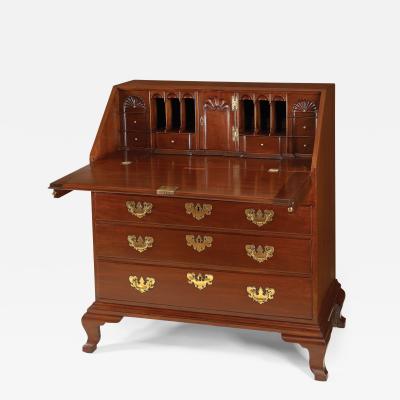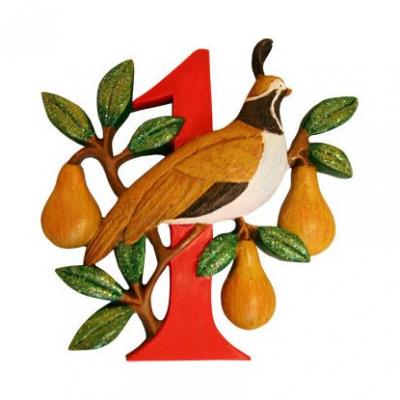Stretch: America's First Family of Clockmakers
This archive article was originally published in the Summer 2013 issue of Antiques & Fine Art magazine.
A constant complaint voiced by early settlers of Philadelphia and its environs was that “they scarcely knew how time passed, nor that they hardly knew the day of Rest, or the Lord’s day, when it was.” 1 William Penn (1644–1718), Pennsylvania’s founder, was among them when he insisted that city residents have a means for telling time so that “the hours for work and meals to Labourers are fixt, and known.” 2 Their need to know the time of day and day of the week set the stage for the arrival of Peter Stretch (1670–1746), one of early America’s most celebrated clockmakers.
Stretch, born to Quaker parents in the hamlet of Harpers Gate, Staffordshire, England, learned the craft of clockmaking from his older brother, Samuel, after which he practiced clockmaking for about a decade in the town of Leek. Though apparently successful, Peter determined to emigrate with his wife, Margery, and four young children to Philadelphia. He arrived in the recently founded city in 1703 and quickly became part of the town’s Quaker ruling elite, commencing his forty-three-year career as Philadelphia’s leading clockmaker.
The clocks Stretch crafted in his house/shop on the southwest corner of Second and Chestnut streets, with the help of three of his sons, Daniel (1694–1735), Thomas (1697–1765), and William (1701–1748), as well as other apprentices and journeymen, combine technology and artistry with an impressive level of workmanship. These clocks, 143 of which are known to have survived, also document the evolution of clockmaking in Philadelphia during the brass dial period (1700–ca. 1780), while the complexity of some of them represent the acme of the craft in America at that time.
His earliest movements, comprising thirty-hour and eight-day, square-dial clocks, date between 1703 and about 1720 and are little different from those he made in Leek.3 The dials of his thirty-hour clocks (Fig. 1), which are signed on the bottom edge of the chapter ring (always silvered originally), measure from nine to eleven inches square and record time in fifteen-minute units, calibrated on the inside edge of the chapter ring, with a single hand. Their movements are driven by a single weight suspended on an endless chain (or rope) that loops over both the time and strike pulleys. All are fitted with an anchor recoil escapement and seconds-beating pendulum controlling the time, while a count wheel controls the strike on a large bell.

- Fig. 5: Arch-dial, eight-day, small moon clock, Peter Stretch (1670–1746), ca. 1725–1730. Clock: brass, iron, steel, bronze, silver. Case: maple, pine, brass, glass. H. 100½, W. 21, D. 10½ in. Private collection. This is the only maple case discovered to date housing a Stretch movement, most being made of walnut with a few in cherry and mahogany. It is attributed to the Philadelphia cabinetmaker John Head (1688–1754), who worked closely with Peter Stretch.
His eight-day, square-dial clock dials (Fig. 2) vary from ten to fourteen inches square, with twelve inches as the norm. They are fitted with three hands that indicate the hour, minute, and second on two chapter rings, the primary one with engraved roman numerals for the hours and arabic numbers for the minutes, while the smaller secondary ring has the seconds noted with arabic numbers. As such, these clocks measure time more accurately than thirty-hour clocks. This is achieved by separating the time and strike trains and driving each with its own weight on cords. These clocks utilize the same anchor recoil escapement and seconds-beating pendulum as thirty-hour clocks, but the design of their strike mechanism evolved. Earlier examples (1703–ca. 1720) use the count wheel, but it was replaced by the rack and snail during the 1720s. The latter automatically synchronizes indicated time and the strike, which the former does not. In addition to telling the hour, minute, and second, Stretch’s eight-day, square-dial clocks tell the day of the month, which his thirty-hour clocks do not.4
Perhaps the most profound evolutionary change Stretch incorporated into his clocks occurred about 1720. That was the advent of the arch dial, which significantly altered the design of tall clocks and provided for additional functions. His arch-dial clocks quickly became the norm. Of these, Stretch made four types. The basic model incorporated an applied boss in the center of the arch engraved with his name (Fig. 3). Slightly more complicated was the metronomic model that featured an oscillating ornament at the center of the arch, the design of which varied from a small circular disk viewed through a narrow opening (Fig. 4), to a rocking ship in front of a painted seascape. The third variant displayed the phases of the moon during the lunar month and the daily tides (Figs. 5–7, 10, and 11). These were important features for residents of port cities like Philadelphia, who depended on marine travel and trade over land routes for their livelihood. The fourth and rarest variant had a provision to silence the hourly strike with a pointer in the arch that was turned manually (Figs. 8, 9).

- Fig. 6: Dial of clock shown in figure 5. H. 16¾, W. 12¼ in. The name “Peter Stretch” and “Philadelphia” are engraved near the bottom of the chapter ring. The elaborately pierced plate applied to this clock dial is engraved with the Latin phrase “TEMPUS RERUM IMPERATOR” (“Time is the commander of all things”), which was adopted as the motto of the Worshipful Company of Clockmakers in London in 1671.
Stretch was occasionally commissioned to make more complicated clocks. Two in particular are notable. One plays a twenty-eight-note musical tune on a nest of five graduated bells, in addition to striking the hours.5 The other announces each quarter hour on a nest of six graduated bells, while a seventh bell notes the hours (Fig. 11).
Throughout his career, Stretch worked closely with cabinetmakers, who fashioned cases for his clocks. To a large degree, the dimensions of these clock cases depended on the size of the dial (ten inches wide in earlier clocks, giving way to twelve inch dials) and the immutable length of the seconds-beating pendulum.
Design elements for clock cases generally followed fashions prevalent in the Old World, particularly England. The earliest cases were fashioned almost exclusively from walnut, but as mahogany became more available as a result of increasing Caribbean trade in the second half of the eighteenth century, it largely supplanted walnut.
Most of the case design changes took place in the upper portion of the hood, or bonnet, for two very different reasons. The first of these relates to the earlier clocks, following the fashion in England, which had sarcophagus or tea caddy pediments, usually of three distinct steps at the very top. It is most likely that clocks presently having flat tops were originally fitted with a sarcophagus pediment that was removable, so that if ceiling height were a problem, this pediment could be easily detached from the rest of the case. As fashions changed, around 1750, the sarcophagus pediment was gradually replaced by the broken arch, consisting of two large opposed scrolls.
The second reason for the design changes was that as complications, or additional functions, were added to the movements, it was necessary to fashion an arch at the top of the dial door to accommodate the dial. While the arch dial was originally intended to allow for the fitting of moon and/or tide dials or strike/silent levers, even clocks without additional functions retained the arch, used in this case to display the maker’s name boss.
Even before the sarcophagus was supplanted by the broken arch pediment, straight or ogee bracket feet had replaced turned “bun” feet. Also, the oculus in the waist door, originally intended to view the going pendulum, was in many instances eliminated around 1720 because of the addition of a visibly moving seconds hand. In virtually all examples, the presence of an arched dial door required for stylistic reasons a conforming arched crest on the waist door. As cases became more ornate, frequently blind fretwork was added to the tympanum or frieze, or both.
Certain design elements stayed remarkably consistent throughout the period 1700–ca. 1780. Three turned ball-and-spire finials on plinths would have originally been present on virtually all examples. All of the clocks shown here have four turned, engaged colonnettes flanking the movement. With somewhat later clocks, the colonnettes would remain, but they would become free-standing. Sidelights are also a common feature, although over time, as arched dials developed, they, too, featured arched crests.
The case of the clock shown in figure 7 contains design elements rarely seen on even the most sophisticated examples of this early period in American timekeeping. Possibly unique floral and foliate carving (attributable with certainty to Samuel Harding, who died in 1758) adorn the upper step of the sarcophagus. Egg-and-dart, fillet, and dentil moldings are just some of the embellishments on the case. Additionally, it is the only recorded American clock case bearing a coat of arms. Incorporated into the fretwork above the dial door is the coat of arms of merchant Clement Plumstead (1680–1745), who in addition to serving a term as mayor of Philadelphia lived across the street from Peter Stretch and served with him on the Common Council.
Another clock case that stands out in this grouping is illustrated in figure 5. It is fashioned from maple, rare among cases of this or any period. It may be that maple was specified by the owner of the clock or that walnut was simply not available at the time to the case maker.
At least two of the cases shown here (figs. 5, 12) can be attributed, on the basis of several unique construction details, to the cabinetmaker John Head (1688–1745). Head’s account book spanning the years 1718 to 1754 shows that he billed Peter Stretch for forty-one cases and his son William for another four.6
This article was originally published in the Summer 2013 issue of Antiques & Fine Art magazine, a fully digitized version of which is available at afamag.com. AFA is affiliated with Incollect.
1. Samuel Atkins, Kalendarium Pennsilvaniense (Philadelphia: William Bradford, 1686), title page.
2. William Penn, A Further Account of the Province of Pennsylvania (Warminghurst Place: Privately printed, 1685).
3. An important exception are lantern clocks, several of which survive signed “Peter Stretch, Leek.” Insofar as is presently known, he did not make lantern clocks during his Philadelphia sojourn, presumably because Philadelphians did not want them. It should also be noted that although Stretch made many eight-day, square-dial clocks between 1703 and 1720, clocks of this type continued in demand long after 1720.
4. One of the seven Peter Stretch thirty-hour clocks found during this survey indicates the day of the month.
5. This clock is owned by Independence National Historical Park in Philadelphia and is on display at Independence Hall.
6. This account book is owned by the American Philosophical Society in Philadelphia. See Jay Robert Stiefel, Alan Andersen, and Christopher Storb, “The John Head Project, Part 1: Documenting his Work,” Antiques & Fine Art, 9, no. 1 (Autumn/Winter 2008): 190–193.









































